17 Best Surrealist Paintings and the Stories Behind Them
Author:
GeorgeUpdated:
10.01.2025
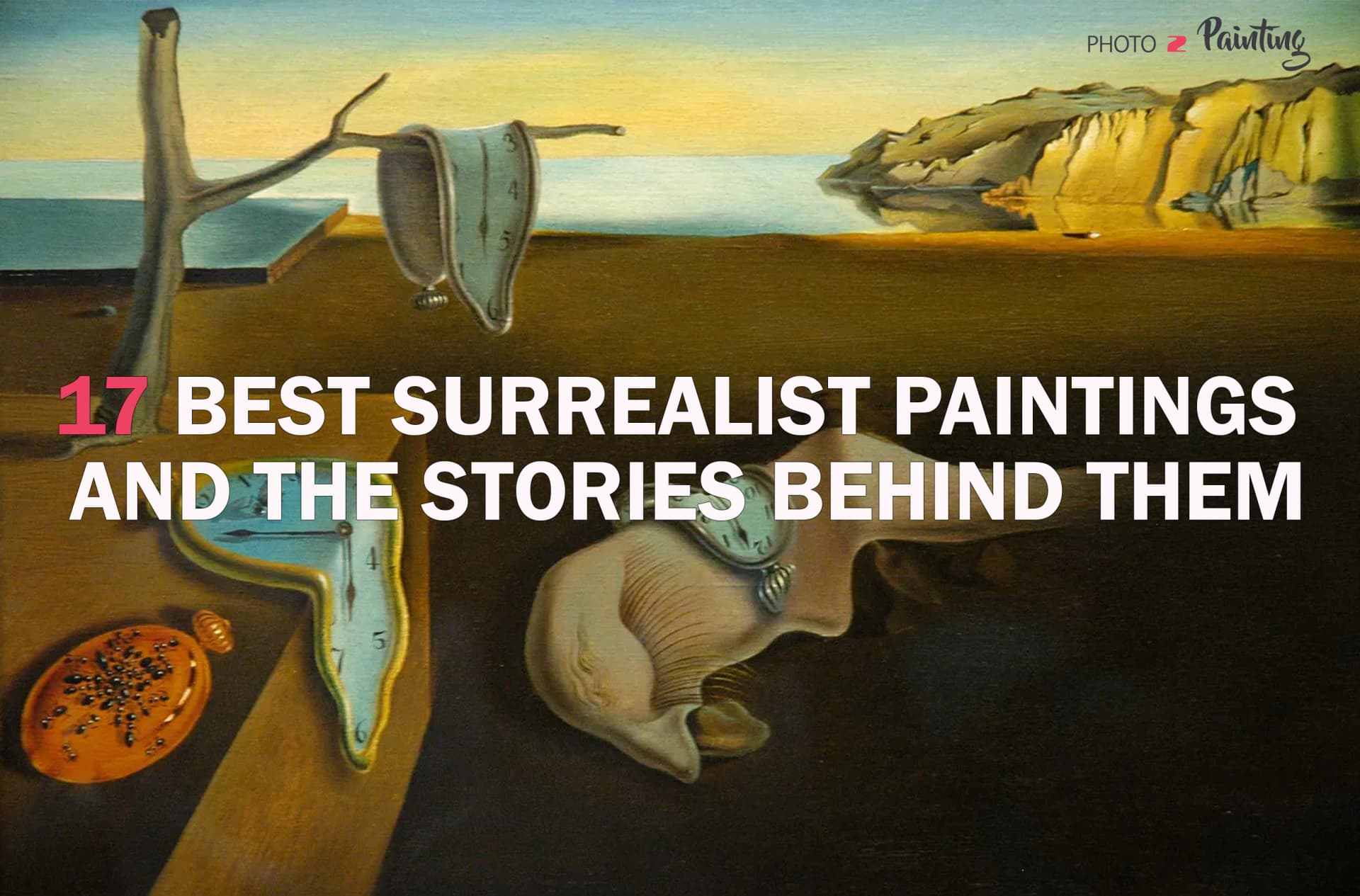

- 1. "The Persistence of Memory" by Salvador Dalí (1931)
- 2. "The Treachery of Images" by René Magritte (1928-29)
- 3. "The Viaduct" by Paul Delvaux (1935)
- 4. "The Song of Love" by Giorgio de Chirico (1914)
- 5. "Son of Man" by René Magritte (1964)
- 6. "Dream Caused by the Flight of a Bee Around a Pomegranate a Second Before Awakening" by Salvador Dalí (1944)
- 7. "The Lovers" by René Magritte (1928)
- 8. "The Scream" by Edvard Munch (1893)
- 9. "The Great Masturbator" by Salvador Dalí (1929)
- 10. "The Elephant Celebes" by Max Ernst (1921)
- 11. "Guernica" by Pablo Picasso (1937)
- 12. "Golconda" by René Magritte (1953)
- 13. "Aquis Submersus" by Max Ernst (1919)
- 14. "Eine Kleine Nachtmusik" by Dorothea Tanning (1943)
- 15. "Green Tea" by Leonora Carrington (1942)
- 16. "Creation of the Birds" by Remedios Varo (1957)
- 17. “The Truth About Comets” by Dorothea Tanning (1945)
- The Impact of Surrealism on Modern Art
Have you ever looked at a painting that felt like a dream, full of mystery and strange meanings? Surrealist paintings have a way of pulling us into their world, making us question what’s real and what’s not. But many people find it hard to understand why these artworks are so fascinating. While some might think Surrealism is just random, strange images, creating such art takes more than that—it needs emotions, ideas, and symbolic depth to bring the vision to life.
Without knowing the stories behind these paintings, it’s easy to think they’re just strange or confusing. You might miss the powerful symbols, creative techniques, and deep ideas about the mind that make them so special.
As André Breton, the founder of Surrealism, said:
"Surrealism is destructive, but it destroys only what it considers to be shackles limiting our vision."
Without understanding its depth, the meaning of Surrealism can remain unclear.
The stories behind the 17 best Surrealist paintings reveal a world where imagination knows no limits. From Salvador Dalí’s melting clocks to René Magritte’s mysterious figures, each masterpiece opens a door to the dreamlike and the extraordinary. Let’s dive into the surreal and uncover their secrets.
1. "The Persistence of Memory" by Salvador Dalí (1931)
"The Persistence of Memory" (1931) by Salvador Dalí is one of the most famous Surrealist paintings, known for its strange and unforgettable imagery. The painting shows a quiet, dreamlike scene with melting clocks hanging over tree branches, a soft and strange figure, and other objects in a bare, empty landscape. The melting clocks are a symbol of how time can feel soft and flexible, not solid or steady.
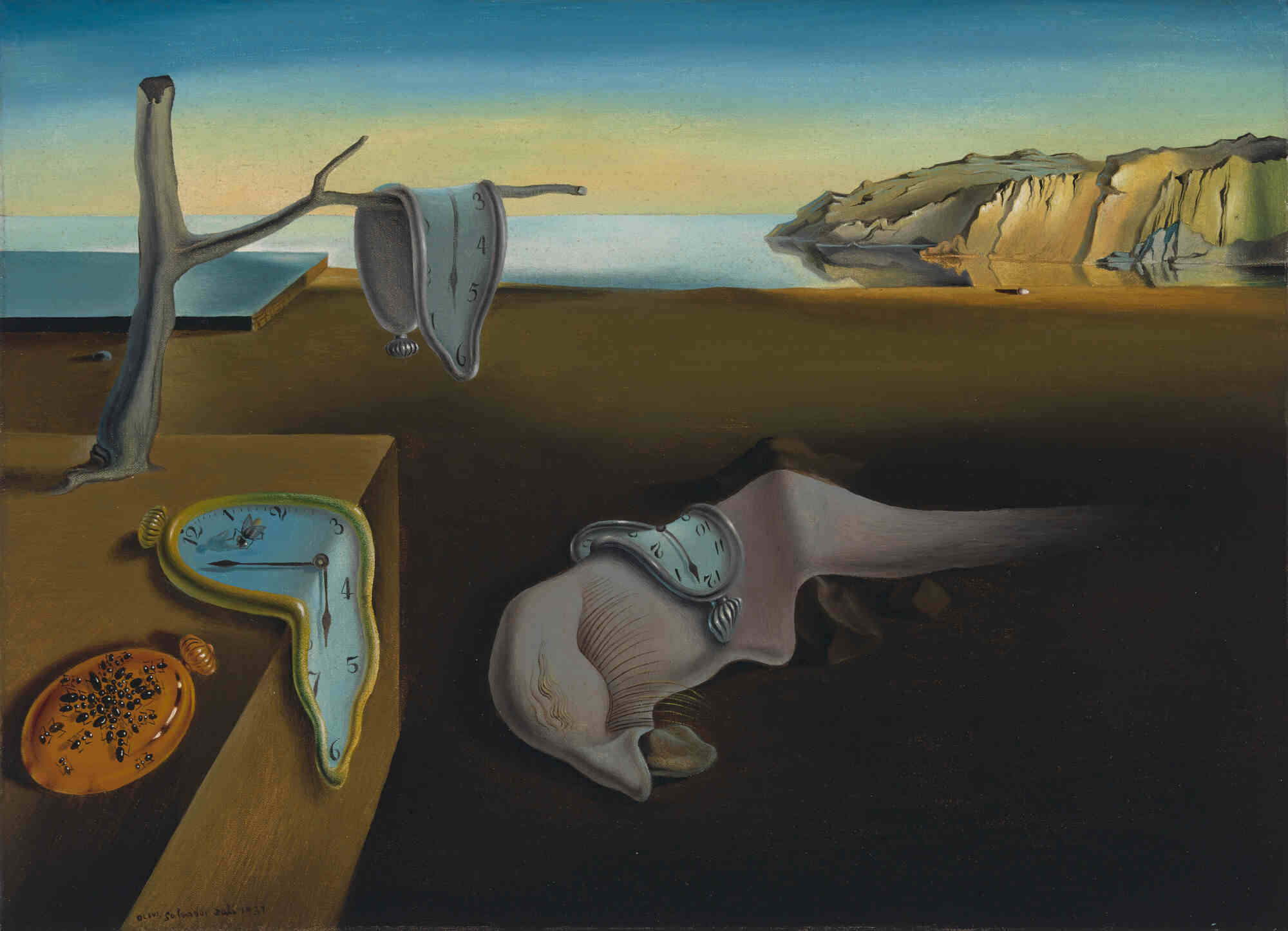
The title, "The Persistence of Memory," suggests that even though time passes quickly, it stays in our minds and shapes how we remember things. There are also small details, like ants crawling on one clock, which could show decay and the idea of time breaking down. The calm and lonely background adds to the mystery and makes the painting feel like a moment taken from a dream. This famous artwork continues to amaze people with its unique ideas about time, memory, and imagination.
2. "The Treachery of Images" by René Magritte (1928-29)
"The Treachery of Images" (1928-29) by René Magritte is a famous Surrealist painting that challenges how we see and understand reality. It shows a simple, realistic image of a pipe, but beneath it, Magritte wrote the words "Ceci n'est pas une pipe" ("This is not a pipe"). This statement seems confusing at first, but it highlights an important idea: the image is not a pipe itself, but just a picture of one. Magritte wanted to make viewers think about the difference between objects and the way we represent them through images and words.
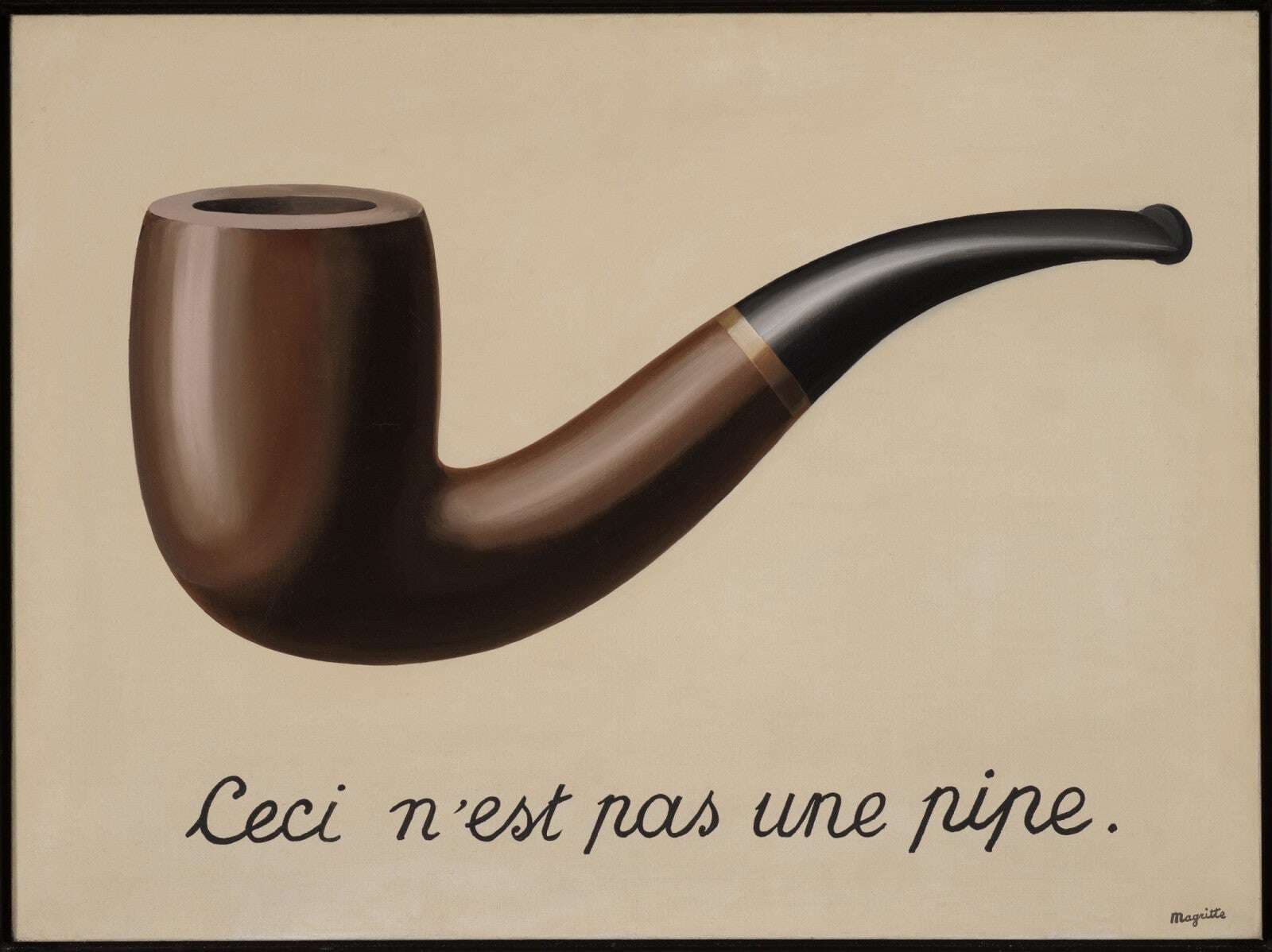
The painting reminds us that what we see or say is often just a symbol, not the real thing. Over the years, "The Treachery of Images" has become a famous and thought-provoking work, encouraging people to question how we perceive the world and communicate meaning.
3. "The Viaduct" by Paul Delvaux (1935)
"The Viaduct" (1935) by Paul Delvaux is a quiet and dreamlike painting. It shows a large bridge, or viaduct, in the background under a soft moonlit sky. In the front, there are still, nude female figures that look like statues, adding a strange and mysterious feeling to the scene.
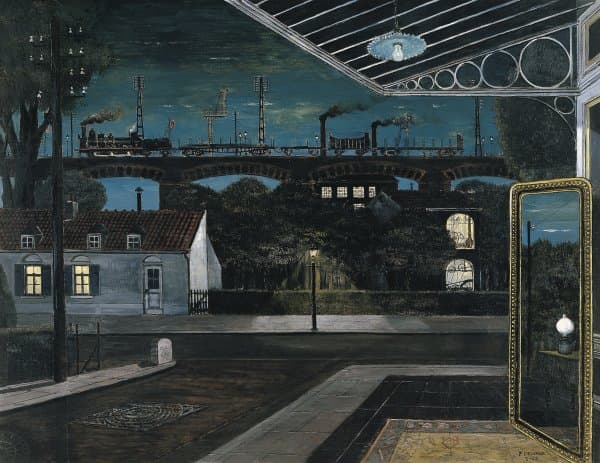
Delvaux uses gentle light and shadows to make the painting feel calm but also a little eerie, as if it belongs to a dream. The quiet atmosphere and unusual details make viewers wonder about the story behind the scene. "The Viaduct" is a great example of Delvaux’s style, where real and unreal elements are mixed together in a simple but powerful way.
4. "The Song of Love" by Giorgio de Chirico (1914)
"The Song of Love" (1914) by Giorgio de Chirico is a mysterious and important painting that helped inspire Surrealism. It shows a strange mix of objects, including a classical statue’s head, a red rubber glove, and a green ball, placed in front of a wall with a cloudy sky in the background. The objects seem random, but their arrangement creates a feeling of mystery and strangeness.
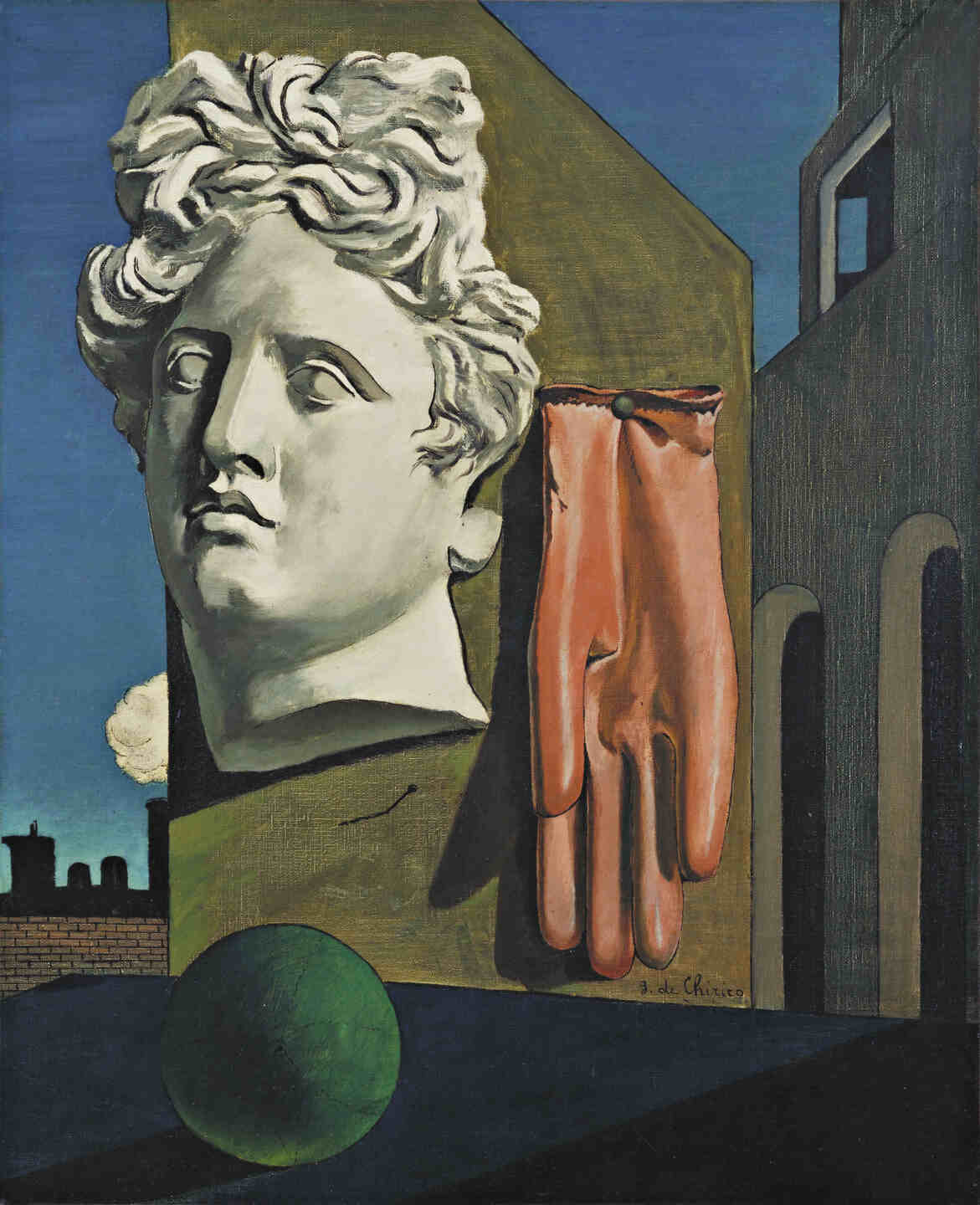
The use of shadows and light makes the scene feel dreamlike. The painting invites viewers to think about the connections between these objects and what they might mean. The Song of Love is a great example of how de Chirico made ordinary things look unusual and thought-provoking.
5. "Son of Man" by René Magritte (1964)
"Son of Man" (1964) by René Magritte is a famous Surrealist painting that explores ideas about identity and how we see the world. It shows a man in a suit and bowler hat standing in front of a plain gray background. His face is hidden by a green apple that floats right in front of him, perfectly covering his features. This makes the man seem both familiar and mysterious.The title, "Son of Man," suggests a connection to humanity, and the apple might symbolize innocence, temptation, or hidden secrets. Magritte’s work makes us think about what lies beneath the surface and how much of what we see depends on what is shown or hidden.
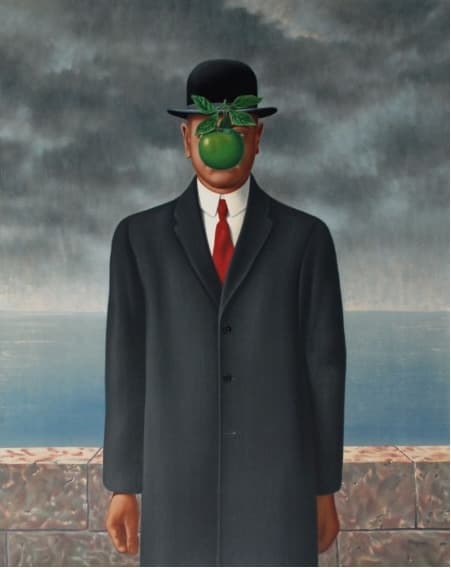
This painting is a great example of Magritte’s Surrealist style, where everyday objects are placed in strange situations, making us question what we know about reality. Its simple but mysterious design continues to fascinate viewers.
6. "Dream Caused by the Flight of a Bee Around a Pomegranate a Second Before Awakening" by Salvador Dalí (1944)
"Dream Caused by the Flight of a Bee Around a Pomegranate a Second Before Awakening" (1944) by Salvador Dalí is a perfect example of his surrealist style, showing a strange and dreamlike scene. The painting was inspired by a dream Dalí had. It shows a woman sleeping in the foreground, while unusual and distorted images surround her. These include a horse’s head, melting objects, and floating shapes. A small bee, which seems to cause the dream, flies near a pomegranate.
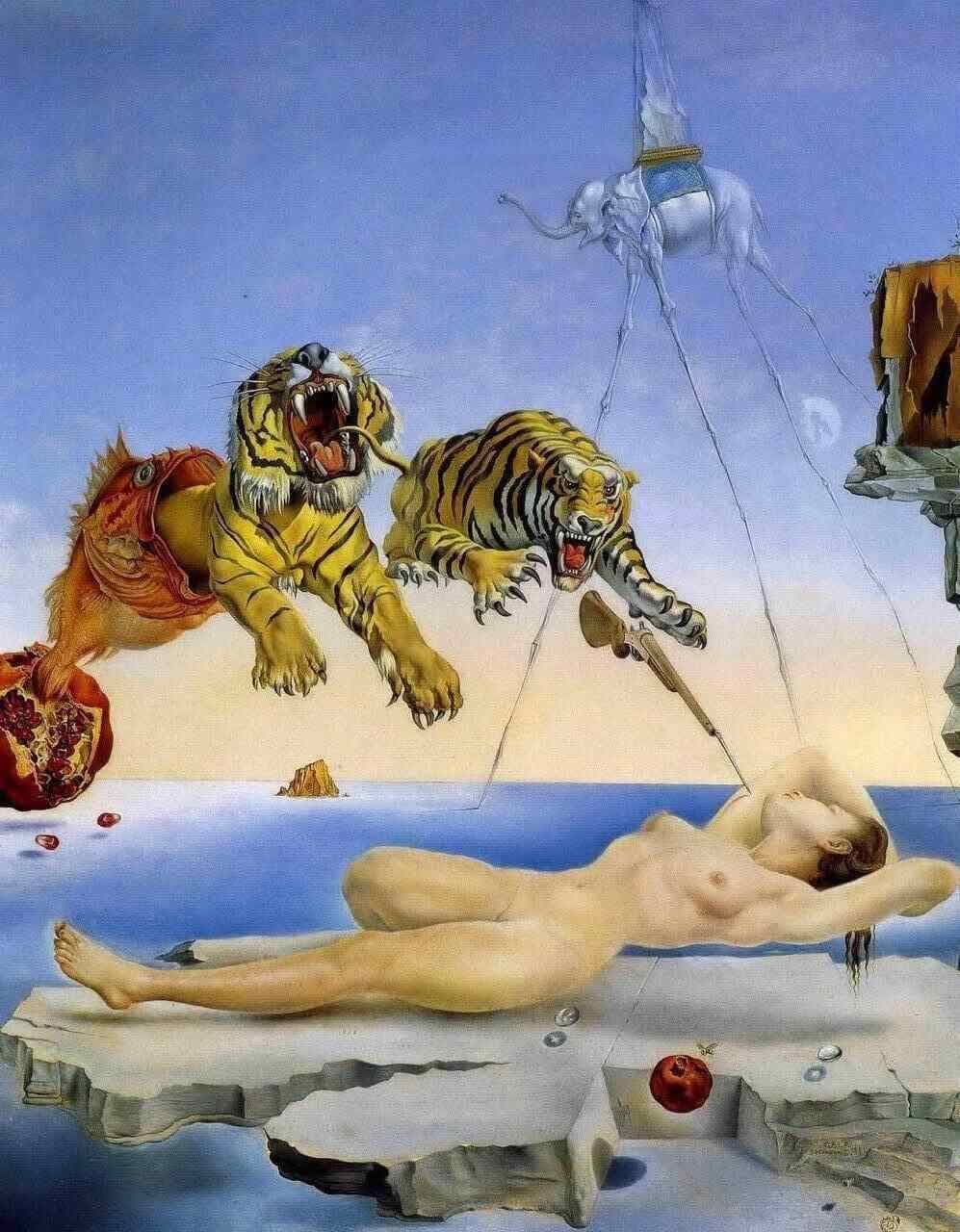
The painting is a visual version of a dream, capturing the strange and illogical thoughts that come from the subconscious mind. Bright colors, unusual forms, and powerful symbols make the scene feel both unsettling and fascinating.
This work highlights Dalí’s skill in surrealism and his talent for turning the mysteries of dreams into art, inviting viewers to reflect on their own subconscious thoughts.
7. "The Lovers" by René Magritte (1928)
"The Lovers" (1928) by René Magritte is a famous Surrealist painting that looks at the mystery of human relationships. It shows two people standing close together, face-to-face, but their faces are covered by white cloth. Even though they are physically close, the clothes create a feeling of distance between them.
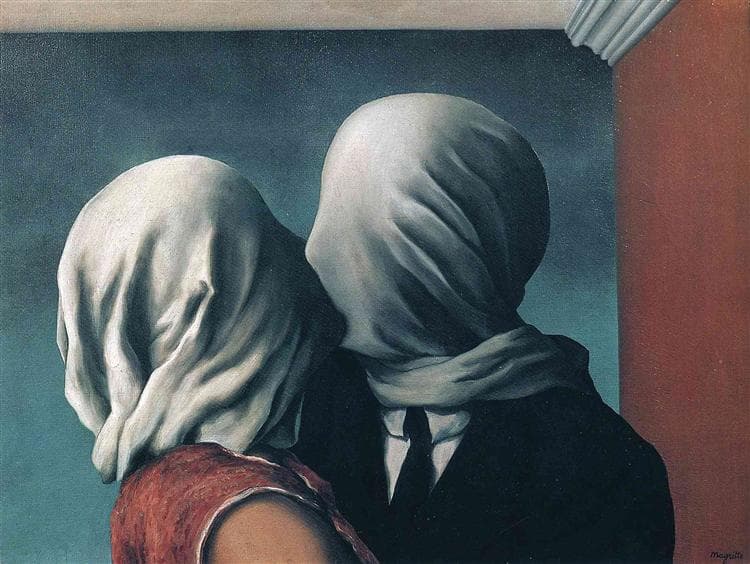
The white cloths symbolize the idea that it is hard to truly know or understand someone, even in close relationships. The title, "The Lovers," feels ironic because, while they are near each other, they seem emotionally far apart. The simple colors and quiet scene add to the painting’s strange and mysterious feeling.
This painting is a great example of Magritte’s style, where everyday scenes are turned into something symbolic and thought-provoking. It makes us think about love, connection, and the barriers that exist between people.
8. "The Scream" by Edvard Munch (1893)
"The Scream" (1893) by Edvard Munch is a famous painting that shows the intense feelings of fear and anxiety. It features a person standing on a bridge, their face twisted in a silent scream. The figure has their hands on their ears, as if trying to block out a loud noise. Behind them, the sky is filled with swirling reds and oranges, adding to the feeling of chaos and tension.
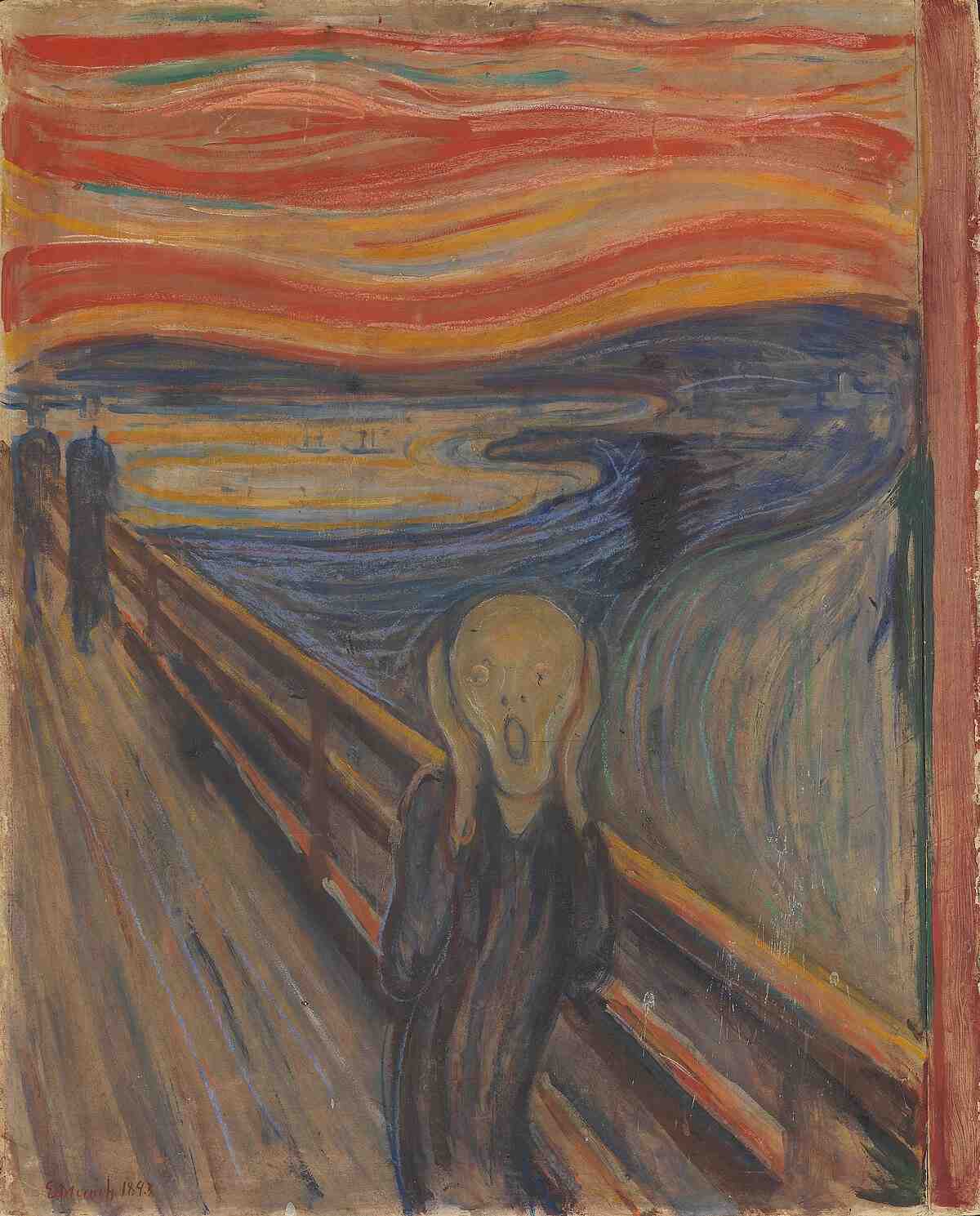
Munch created several versions of this painting, but the most well-known one, painted with tempera on cardboard, is in the National Gallery of Norway in Oslo.
This painting has become a symbol of human emotions like anxiety and loneliness, capturing the fear and uncertainty of modern life. Its powerful image still connects with people today, showing how art can express deep, universal feelings.
9. "The Great Masturbator" by Salvador Dalí (1929)
"The Great Masturbator" (1929) by Salvador Dalí is a strange and unsettling painting that looks at themes of sexuality, religion, and the subconscious mind. It shows a distorted self-portrait of Dalí, with his face turned into a mask-like shape. The image includes symbols like a lobster claw, a conch shell, and a decaying face, all hinting at ideas of desire, death, and hidden thoughts.
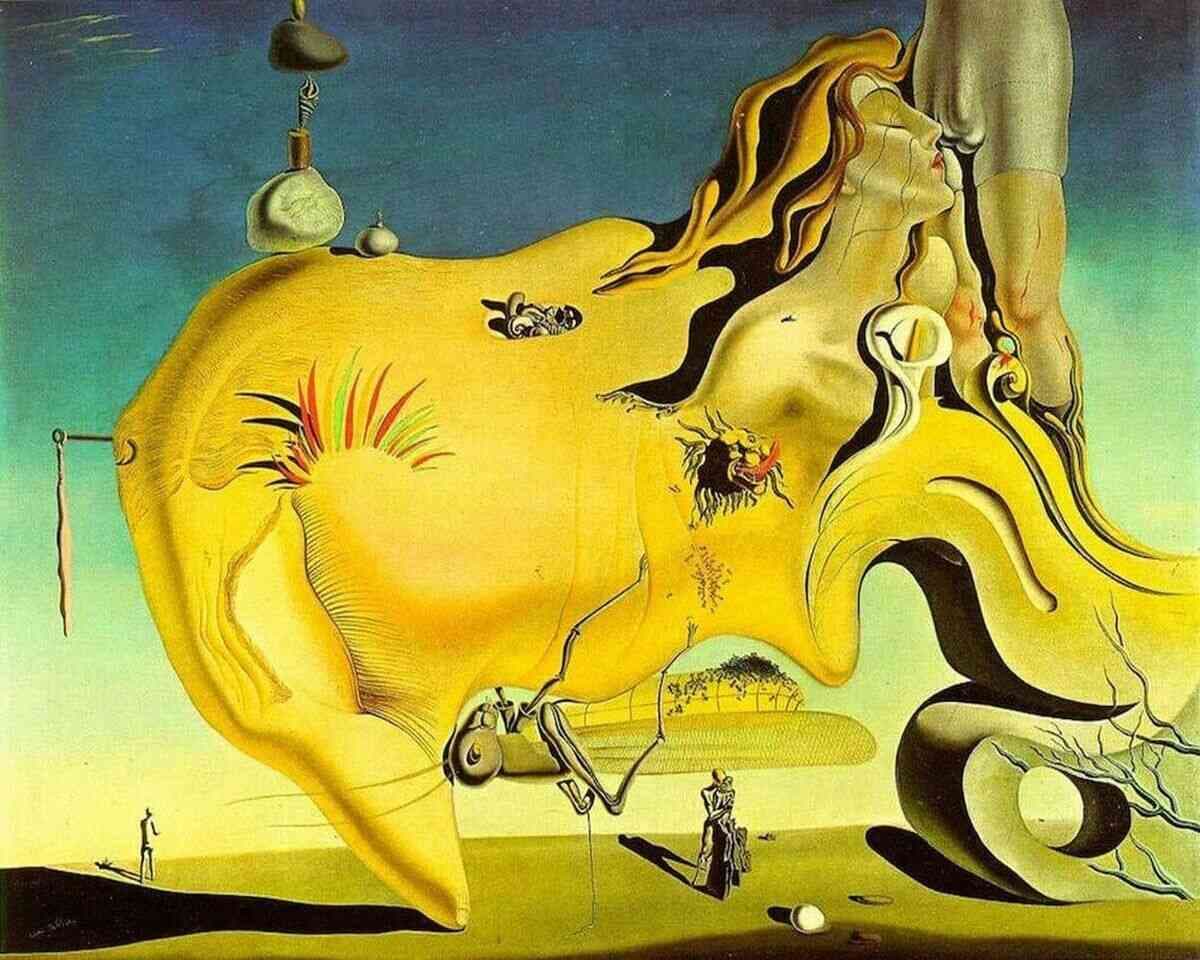
This painting is a strong example of Dalí’s surrealist style, full of dreamlike images and unusual shapes. It is both provocative and mysterious, continuing to intrigue and challenge viewers with its deep and personal symbolism.
10. "The Elephant Celebes" by Max Ernst (1921)
"The Elephant Celebes" (1921) by Max Ernst is a strange and fascinating Surrealist painting. It shows an elephant-like creature with a body that looks mechanical, almost like a machine, and it stands in a bare, empty landscape. The creature’s design is inspired by a grain storage tank Ernst saw in an African photograph, giving it an industrial and surreal appearance. Surrounding the elephant are other unusual details, like a headless figure and scattered objects, which add to the mystery of the scene.
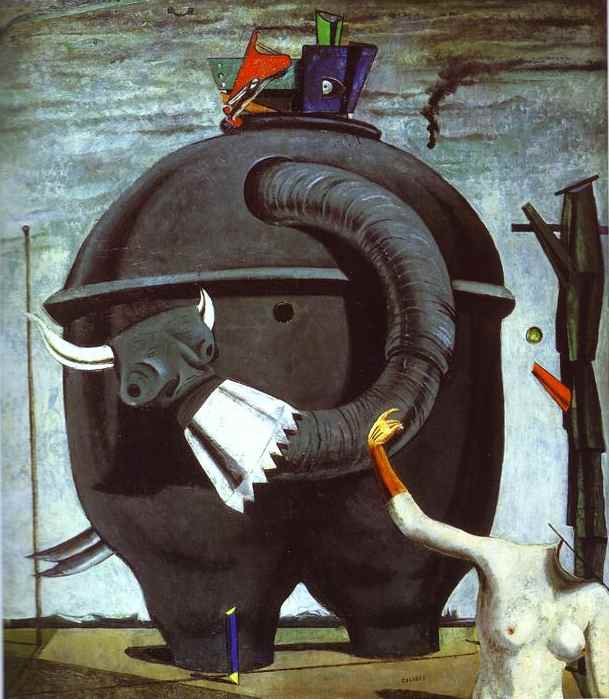
The mix of mechanical and organic features creates a feeling of tension between the real and the imaginary. The painting reflects Ernst’s interest in dreams and the subconscious mind, encouraging viewers to interpret its meaning in their own way. This artwork is a powerful example of how Surrealism turns ordinary objects into something strange and thought-provoking.
11. "Guernica" by Pablo Picasso (1937)
"Guernica" (1937) by Pablo Picasso is a powerful and emotional painting that shows the horror and suffering caused by war. It was created in response to the bombing of the town of Guernica during the Spanish Civil War. The painting is done in black, white, and gray, which gives it a serious and dramatic look.
The scene is filled with chaotic and distorted figures, including a screaming woman holding a dead child, a wounded horse, and a broken soldier. These images represent pain, fear, and destruction. The light bulb at the top of the painting can symbolize both a bomb and a harsh spotlight on the horrors of war.
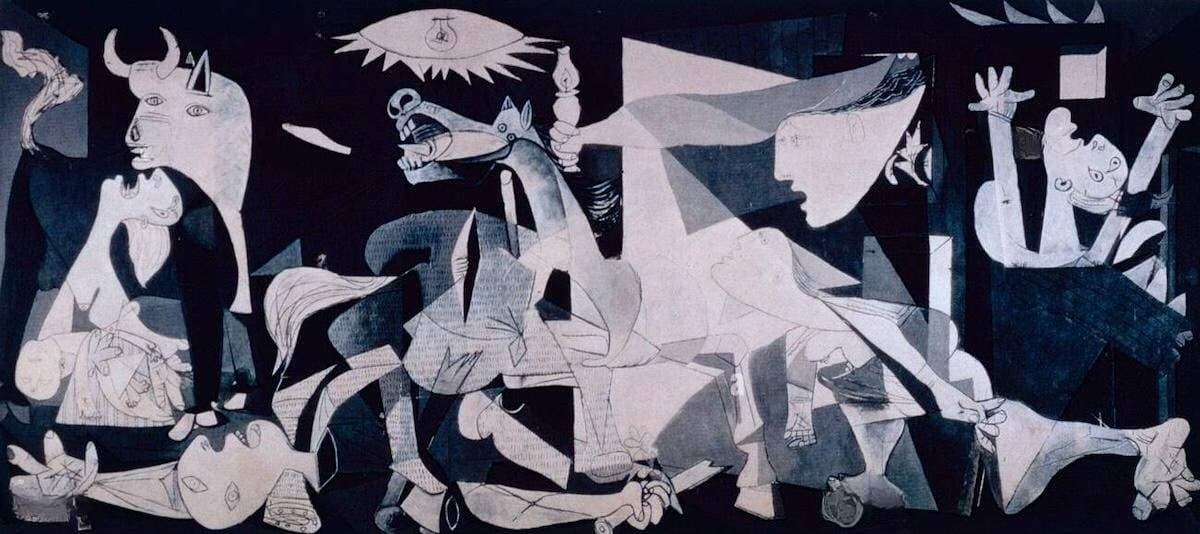
"Guernica" is one of Picasso’s most famous works, known for its strong anti-war message. It continues to remind people of the terrible effects of violence and the importance of peace.
For more examples of how art captures deep emotion, explore these famous sad paintings and their lasting impact.
12. "Golconda" by René Magritte (1953)
"Golconda" (1953) by René Magritte is a fascinating Surrealist painting that plays with ideas of repetition and mystery. It shows a sky filled with identical men wearing dark coats and bowler hats, all floating or falling in a quiet, ordinary town. The men are spaced evenly, giving the painting a strange and dreamlike feeling.
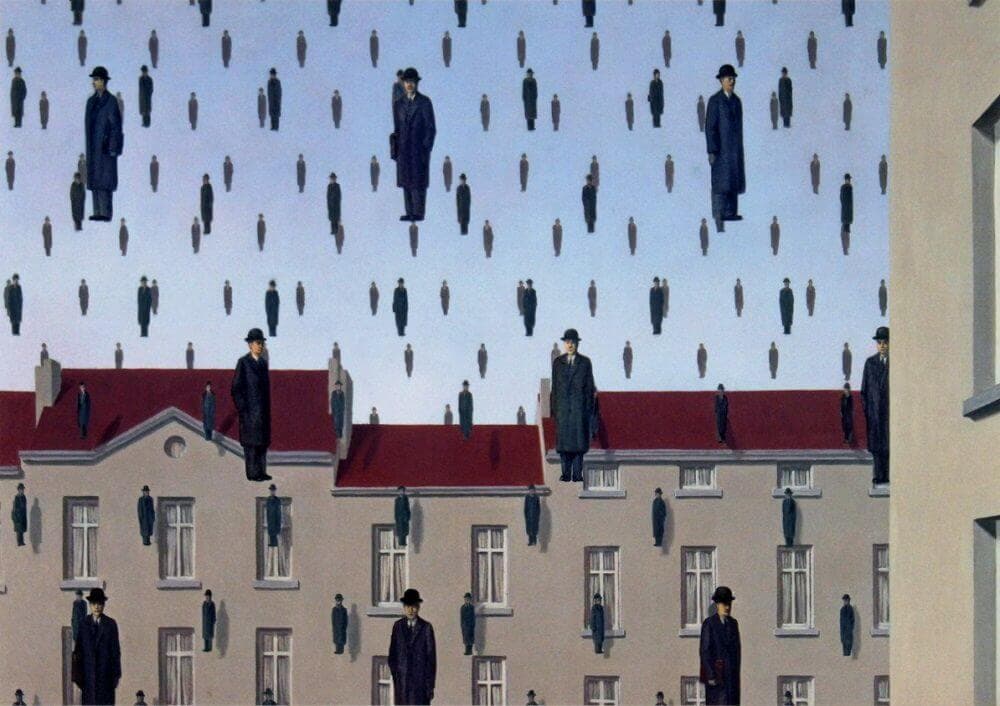
The repeated figures create a sense of order, but the scene feels unnatural and puzzling. Magritte’s use of ordinary clothes and a simple background makes the floating men seem even more out of place. "Golconda" is a great example of Magritte’s ability to turn everyday scenes into something unusual and thought-provoking. It makes viewers question what they see.
13. "Aquis Submersus" by Max Ernst (1919)
"Aquis Submersus" (1919) by Max Ernst is a mysterious and dreamlike painting that reflects his interest in the subconscious and surreal imagery. The scene shows a strange, otherworldly landscape filled with abstract shapes and shadowy figures. The title, which means "submerged in water," adds to the painting’s sense of mystery and suggests themes of drowning or being lost.
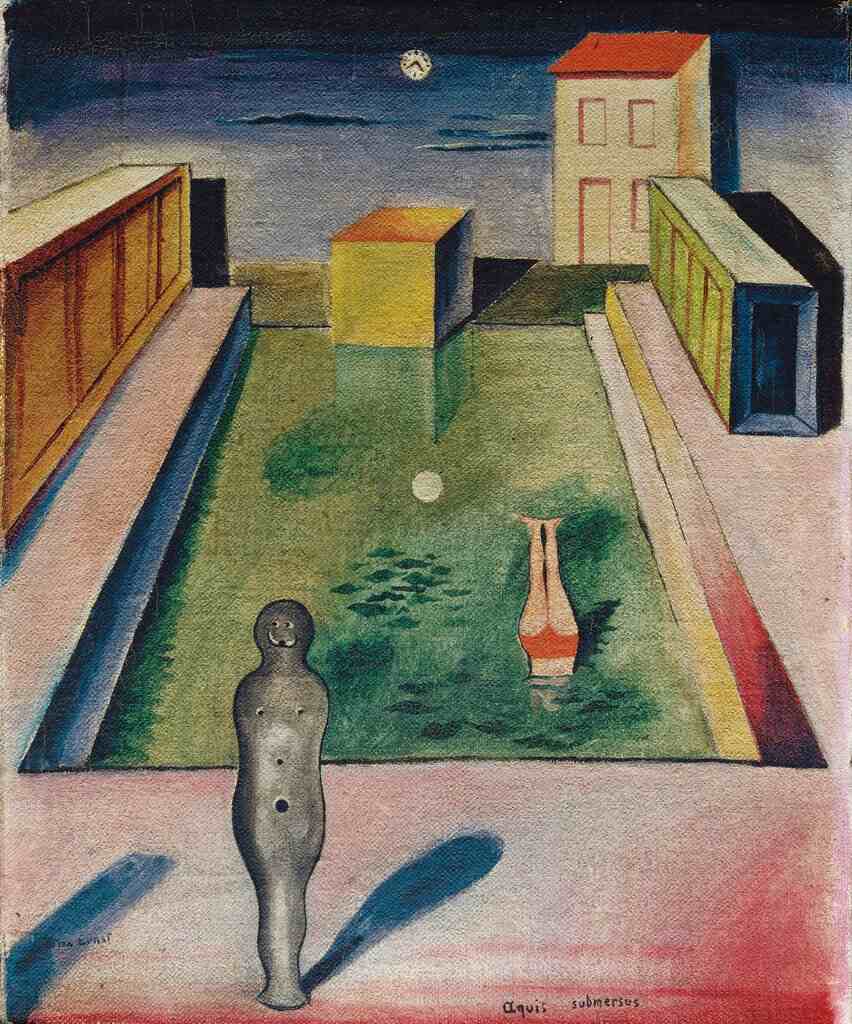
Ernst’s use of texture and unusual shapes creates a haunting atmosphere, making the viewer feel as if they are looking at a scene from a dream or a memory. This painting is an early example of Ernst’s unique style, combining imagination and symbolism to explore deep emotions and ideas.
14. "Eine Kleine Nachtmusik" by Dorothea Tanning (1943)
"Eine Kleine Nachtmusik" (1943) by Dorothea Tanning is a strange and unsettling painting set in a hallway. It shows two young girls, one with long flowing hair and the other with hair standing straight up, as if blown by an invisible wind. Both are wearing torn clothes, adding to the eerie feeling.
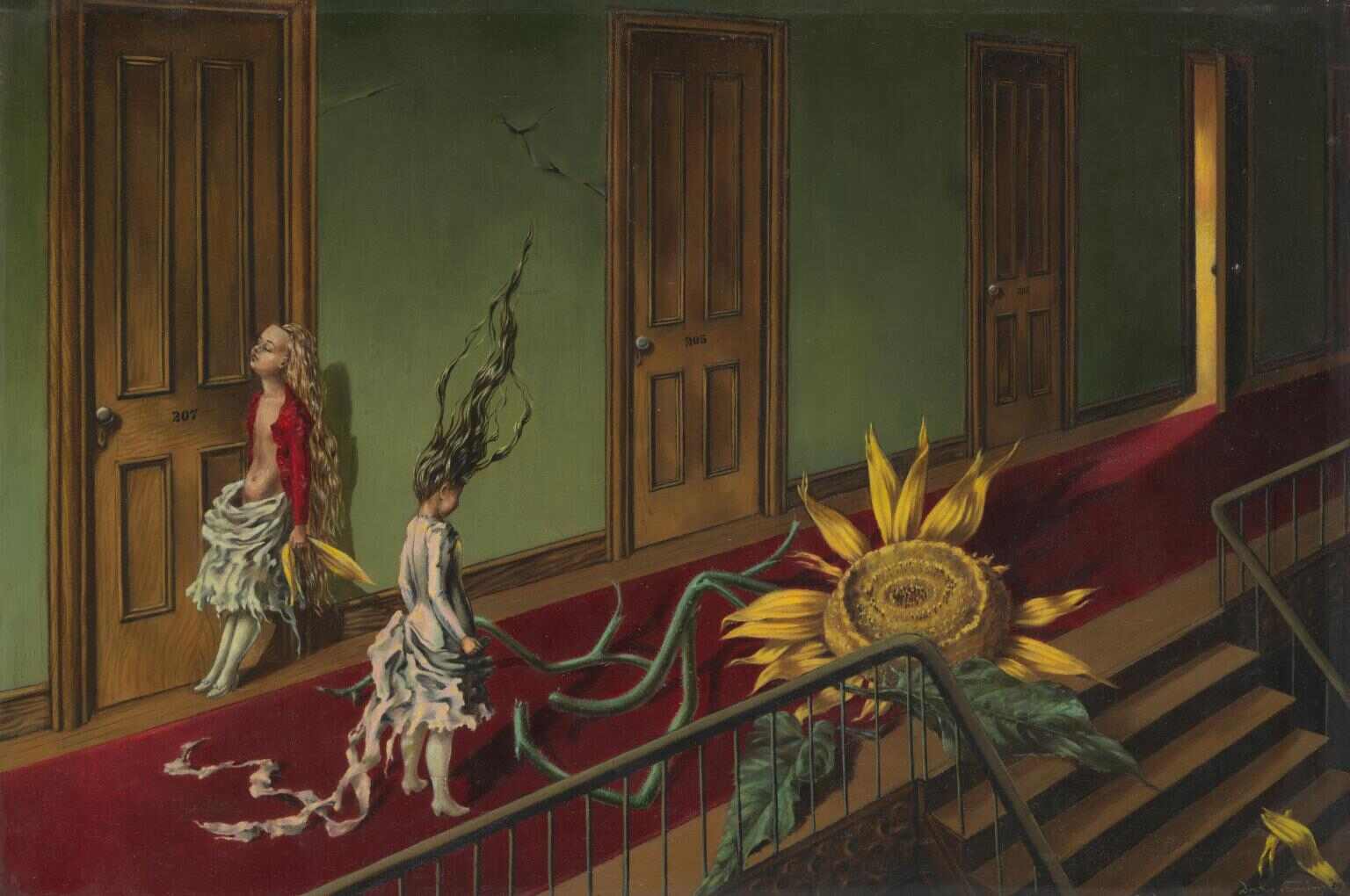
On the right, a giant sunflower with twisting vines takes up much of the space, making the scene feel even more unusual. The numbered doors and cracks in the walls make the hallway look mysterious and trapped, like something out of a dream. This painting is a great example of how Tanning mixes ordinary places with strange and symbolic details, leaving viewers to think about its deeper meaning.
15. "Green Tea" by Leonora Carrington (1942)
This painting, "Green Tea" (1942) by Leonora Carrington , is a surreal and imaginative scene filled with strange and dreamlike details. In the center, a figure wrapped in black-and-white cloth stands with a calm expression, wearing a spiked crown and long braided hair. Beside them is a purple, vessel-like object holding small antlered figures.
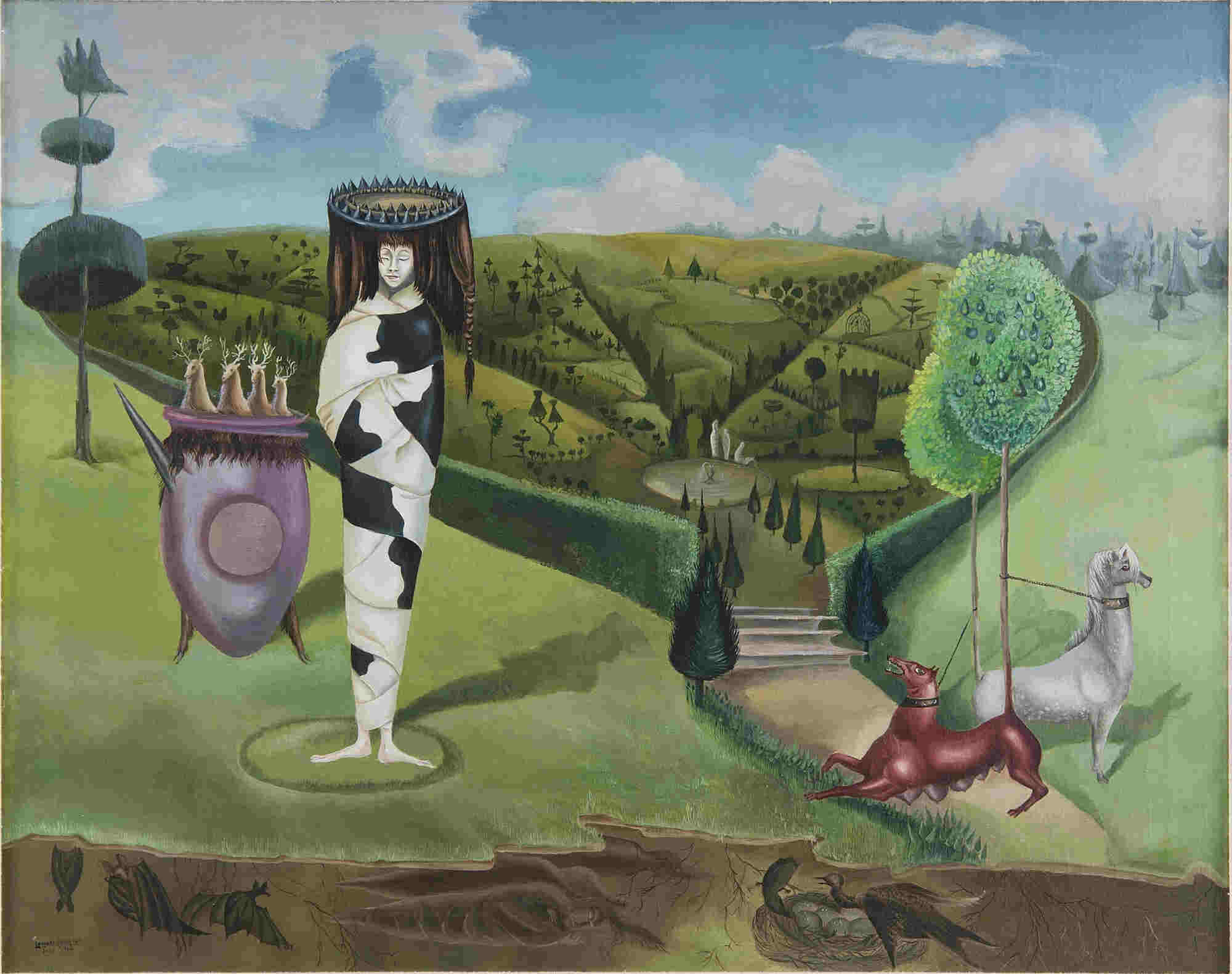
The background is a green, carefully designed landscape with trimmed hedges, winding paths, and distant sculptures. On the right, a red horse and a white horse are tied to two trees, adding to the mysterious and magical feeling of the scene. Carrington’s use of soft colors and unusual objects creates a world that feels both peaceful and strange, inviting viewers to imagine their own stories about what it might mean.
16. "Creation of the Birds" by Remedios Varo (1957)
"Creation of the Birds" (1957) by Remedios Varo is a magical and imaginative painting that shows a bird-like figure creating new birds. The figure sits at a desk, using tools like a violin and a beam of light to bring the birds to life. The scene feels like a mix of science, art, and magic.
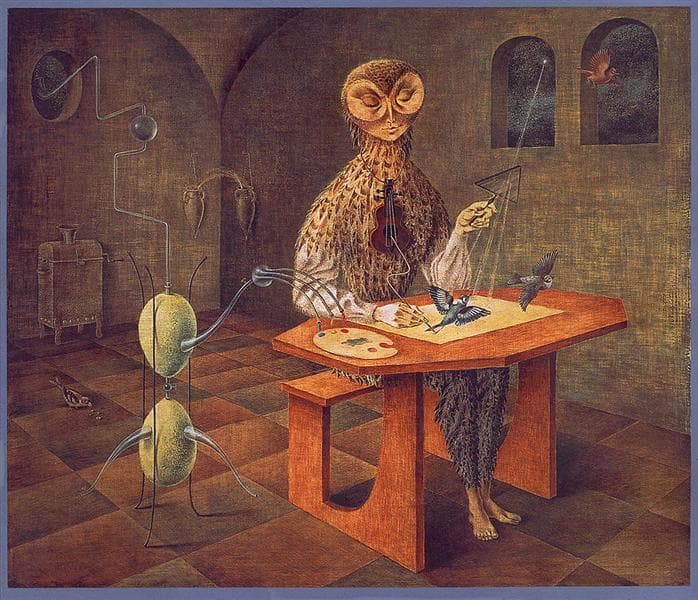
Varo’s detailed and delicate style makes the painting feel like a glimpse into a dream or a fairy tale. The mysterious atmosphere and symbolic imagery invite viewers to think about creativity and the power of imagination. This painting is one of Varo’s most famous works and shows her unique ability to combine the real and the fantastical in a beautiful way.
17. “The Truth About Comets” by Dorothea Tanning (1945)
"The Truth About Comets" (1945) by Dorothea Tanning is a magical and strange painting that feels like a dream. It shows a snowy landscape with a gray, cloudy sky. Two bright comets streak across the sky, lighting up the scene. On the ground, there are two figures with human bodies and snake-like tails, standing near a staircase that seems to grow out of a tree. The staircase leads to nowhere, adding to the mystery.
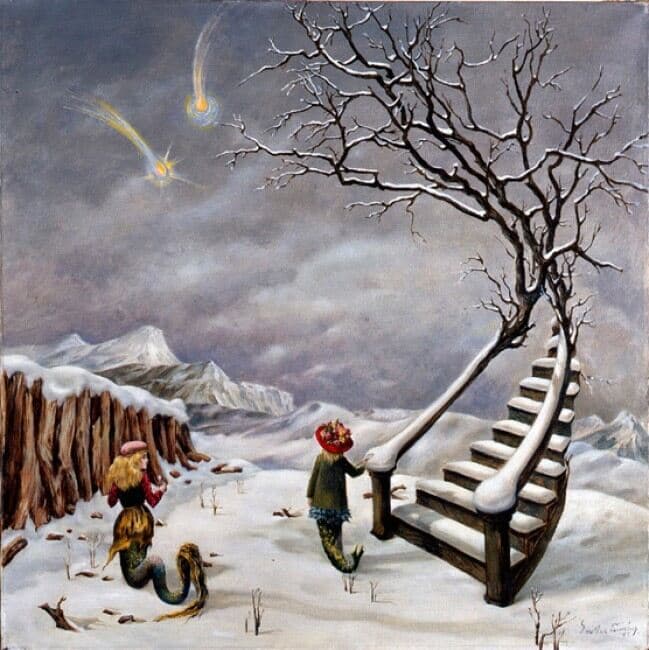
The figures, dressed in colorful clothing, look both playful and mysterious. The bare tree and the snowy setting make the scene feel quiet but also a little eerie. Tanning’s detailed painting style and imaginative ideas make this artwork an amazing example of Surrealism, inviting viewers to wonder about its meaning.
The Impact of Surrealism on Modern Art
Surrealism has had a big influence on modern art, inspiring not only painters but also writers, filmmakers, and designers. It encouraged artists to explore their imagination, look at the subconscious, and break away from traditional rules.
Many modern art movements, such as Abstract Expressionism and Pop Art, were shaped by Surrealism’s ideas of spontaneity and symbolism. Artists like Jackson Pollock adopted Surrealist techniques like automatism, while others embraced the movement's playful and thought-provoking approach.
Beyond traditional art forms, Surrealism’s impact can be seen in modern cinema, fashion, and digital art. Films by directors like David Lynch and Guillermo del Toro reflect its dreamlike storytelling and striking imagery. Even in everyday design, Surrealist influences continue to appear, blending the ordinary with the extraordinary.
Surrealism’s legacy lies in its ability to inspire artists to explore new ideas, question reality, and connect with their inner imagination. It remains a source of creativity and wonder for people all over the world.
Conclusion
Surrealist art continues to amaze people with its dreamlike images and deep ideas about the subconscious. From Salvador Dalí’s melting clocks to René Magritte’s floating apples, these paintings make us look at the world differently and inspire us to think beyond what is ordinary. Surrealism’s influence is still strong today, shaping modern art, movies, and design.
As Salvador Dalí said:
"Surrealism is not a movement. It is a latent state of mind perceivable through the powers of dream and nightmare."
The surrealists showed how everyday things could be turned into something strange and meaningful, proving the power of imagination. Their work encourages us to ask questions, explore new ideas, and see the world in new ways. If you’re inspired by their creativity, you can bring your ideas to life with custom artwork.
Frequently Asked Questions
What makes a picture Surrealist?
A Surrealist picture combines dreamlike imagery, symbolic elements, and unexpected juxtapositions to explore the unconscious mind and challenge reality.
What are the three distinguishing elements used in Surrealist paintings?
The key elements are dreamlike visuals, symbolic representation, and unexpected juxtapositions or transformations.
Which techniques characterize Surrealist painting?
Techniques such as automatism, decalcomania, frottage, collage, and "exquisite corpse" are commonly used in Surrealist art.
Was Frida Kahlo a Surrealist?
No, Frida Kahlo was not officially a Surrealist, though her work contains many surreal elements. She often stated that her art reflected her reality rather than dreams, distancing herself from the Surrealist label.
What are the five common themes in Surrealism artworks?
Common themes include dreams, unconscious desires, transformation, time, and irrationality.
What is the theory of Surrealism?
Surrealism is rooted in André Breton’s manifesto, which highlights the importance of the unconscious mind, dreams, and automatism in creative expression.
How can you tell if a painting is Surrealist?
Look for dreamlike imagery, unexpected juxtapositions, and symbolic or irrational elements that challenge conventional reality.
Why is it called an "exquisite corpse"?
The term comes from a collaborative Surrealist game where artists collectively create an artwork, often with surprising and unexpected results.
What are the two main types of Surrealism art?
The two main types of Surrealism art are Automatism, which focuses on free-flowing and spontaneous creation, and Veristic Surrealism, which emphasizes detailed and realistic depictions of dreamlike scenes.
George, CEO of Photo2painting, is a passionate art lover and entrepreneur. He founded Photo2painting.com from scratch, inspired by his artist friends. As the company's CMO, he manages content and marketing.
Excellent Customer Reviews















































































































































